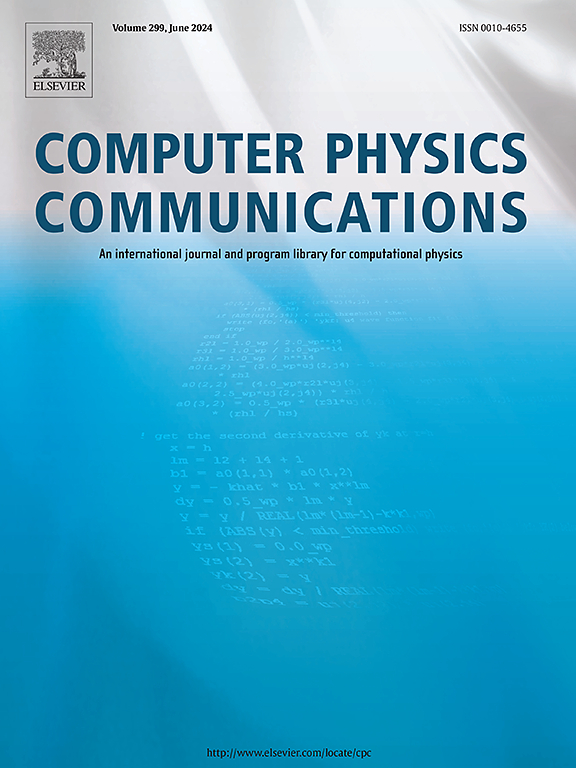GRASPC – GRASP package adapted for the generation of continuum orbitals wave functions
IF 3.4
2区 物理与天体物理
Q1 COMPUTER SCIENCE, INTERDISCIPLINARY APPLICATIONS
引用次数: 0
Abstract
The GRASP package (https://github.com/compas/grasp) is a widely used tool for performing fully relativistic bound electron structure calculations of atoms. Its latest official release is GRASP2018, but it has been continuously developed since then.
The presented code, GRASPC, is the adaptation of that package allowing for calculations of the continuum orbital of electrons elastically scattered from atoms and ions. The calculated continuum orbital can be normalized using the per-energy normalization procedure. Then, the phase shifts are calculated by comparing the computed wave function with the free electron wave function in the asymptotic region. Scattering lengths are estimated not only for widely used very low energy scattering but also using an unusual approach with a “zero energy” wave function.
The main idea behind GRASPC is to use as many computational apparatus as they are implemented in GRASP (e.g., building the atomic and configuration state functions, calculating the potentials, angular coefficients and integrals, constructing the Dirac-Coulomb Hamiltonian, performing self-consistent calculations) by adapting them to calculate the wave function of the scattered electron. This adaptation is entirely transparent for usual calculations in GRASP (bound states and their properties). The default flow changes only when calculations involving continuum orbital are requested and different outputs are produced. This approach, combined with the retention of the typical interactive user interface, allows GRASP users to adapt rapidly to the new type of calculation.
适用于连续轨道波函数生成的GRASP包
GRASP包(https://github.com/compas/grasp)是一个广泛使用的工具,用于执行原子的完全相对论束缚电子结构计算。其最新的官方版本是GRASP2018,但从那时起它一直在不断开发。所提出的GRASPC代码是对该程序包的改编,允许计算从原子和离子中弹性散射的电子的连续轨道。计算的连续体轨道可以使用每能量归一化过程进行归一化。然后,将计算得到的波函数与渐近区域的自由电子波函数进行比较,计算相移。散射长度的估计不仅适用于广泛使用的极低能量散射,而且还使用了一种不寻常的方法,即“零能量”波函数。GRASPC的主要思想是使用尽可能多的计算设备(例如,构建原子和态函数,计算势,角系数和积分,构造狄拉克-库仑哈密顿函数,执行自一致计算),通过调整它们来计算散射电子的波函数。这种适应对于GRASP(束缚态及其属性)中的常规计算是完全透明的。只有当需要计算连续轨道并产生不同的输出时,默认流才会改变。这种方法与保留典型的交互式用户界面相结合,使GRASP用户能够快速适应新型计算。
本文章由计算机程序翻译,如有差异,请以英文原文为准。
求助全文
约1分钟内获得全文
求助全文
来源期刊

Computer Physics Communications
物理-计算机:跨学科应用
CiteScore
12.10
自引率
3.20%
发文量
287
审稿时长
5.3 months
期刊介绍:
The focus of CPC is on contemporary computational methods and techniques and their implementation, the effectiveness of which will normally be evidenced by the author(s) within the context of a substantive problem in physics. Within this setting CPC publishes two types of paper.
Computer Programs in Physics (CPiP)
These papers describe significant computer programs to be archived in the CPC Program Library which is held in the Mendeley Data repository. The submitted software must be covered by an approved open source licence. Papers and associated computer programs that address a problem of contemporary interest in physics that cannot be solved by current software are particularly encouraged.
Computational Physics Papers (CP)
These are research papers in, but are not limited to, the following themes across computational physics and related disciplines.
mathematical and numerical methods and algorithms;
computational models including those associated with the design, control and analysis of experiments; and
algebraic computation.
Each will normally include software implementation and performance details. The software implementation should, ideally, be available via GitHub, Zenodo or an institutional repository.In addition, research papers on the impact of advanced computer architecture and special purpose computers on computing in the physical sciences and software topics related to, and of importance in, the physical sciences may be considered.
 求助内容:
求助内容: 应助结果提醒方式:
应助结果提醒方式:


